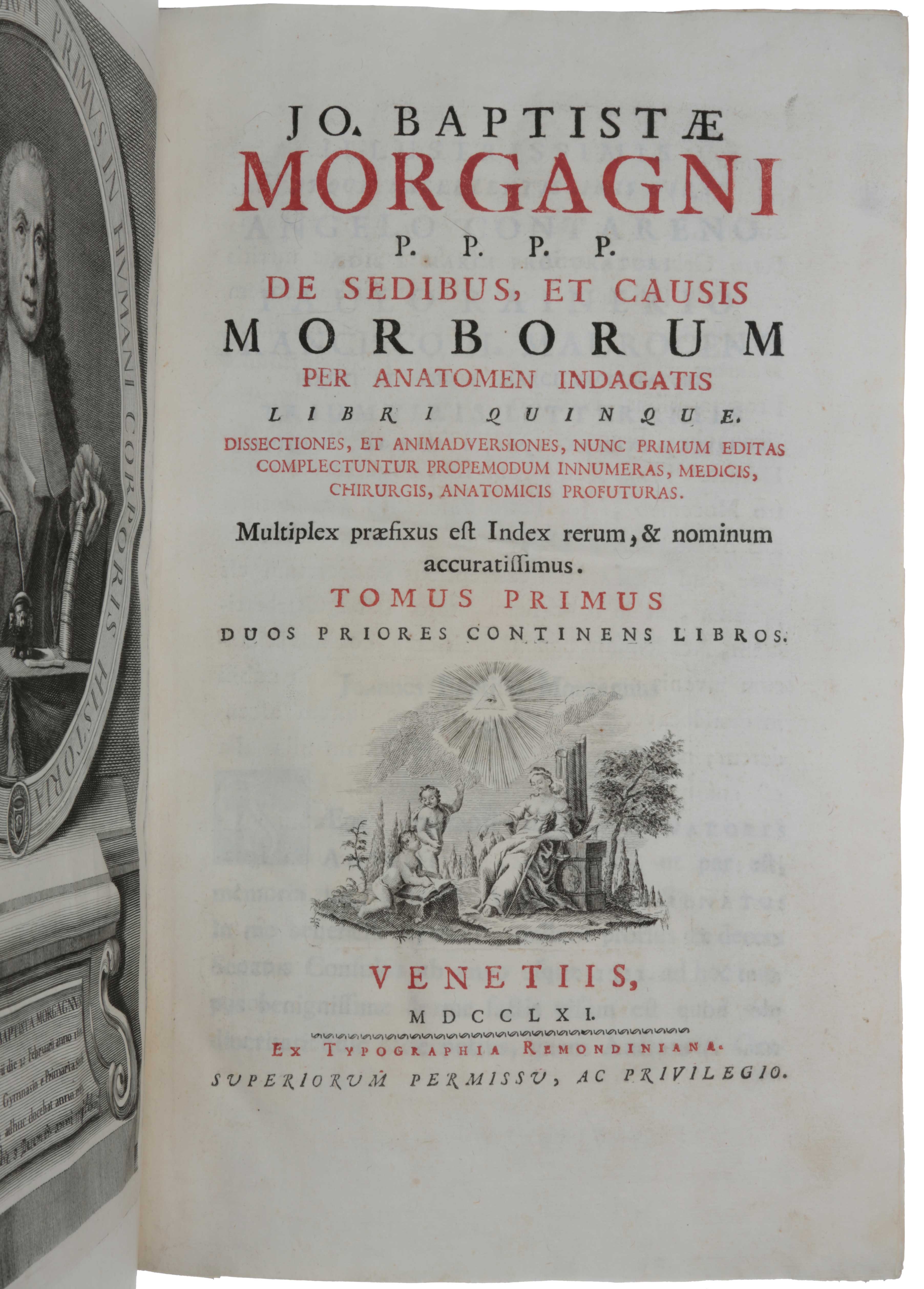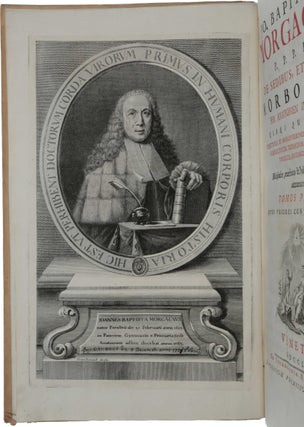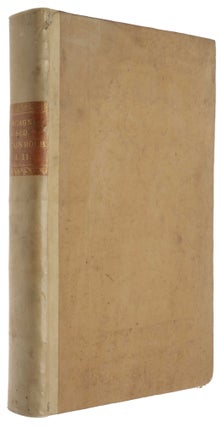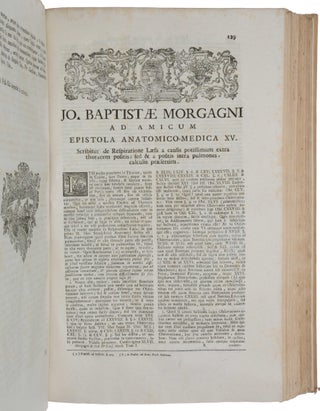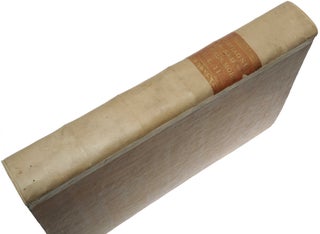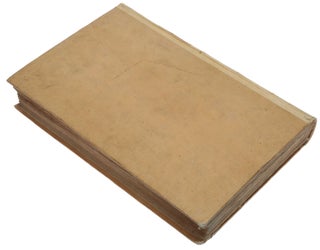De Sedibus, et Causis Morborum per anatomen Indagatis libri quinque. Dissectiones, et Animadversiones, nunc primum editas, complectuntur propemodum innumeras, medicis, chirurgis, anatomicis profuturas.
Venice: Remondini, 1761. First edition, first issue, a very fine copy, of “one of the most important [works] in the history of medicine” (Garrison & Morton). “After Antonio Benivieni (1443-1502), Giovanni Battista Morgagni is considered the founder of pathological anatomy. His ‘De sedibus’, regarded as one of the most important books in the history of medicine, established a new era in medical research” (Norman). “Morgagni’s contribution to the understanding of disease may well rank with the contributions of Vesalius in anatomy and Harvey in physiology” (Heirs of Hippocrates). “On the basis of direct examination and records of some 700 post mortem dissections, he advanced the procedure of basing diagnosis, prognosis and treatment on a detailed and comprehensive knowledge of the anatomical conditions of common diseases. In the above volumes, some of the cases are given with a precision and details hardly surpassed in medical history. His proposal was a shift of emphasis from the traditional ‘nature’ of a disease to its anatomical ‘seat’. It combined the approach of anatomist and pathologist, making their special knowledge available to the diagnostician” (Dibner). Due to this work, “Morgagni may thus be considered to be the founder of pathological anatomy” (DSB). “Rudolf Virchow epitomized Giovanni Battista Morgagni’s influence on the development of modern medicine when he wrote, ‘The full consequences of what he worked out were harvested in London and Paris, in Vienna and in Berlin. And thus we can say that, beginning with Morgagni and resulting from his work, the dogmatism of the old schools was completely shattered, and that with him the new medicine begins.’ This ‘new medicine’ began with the publication of Morgagni’s masterpiece known as De Sedibus et Causis Morborum per Anatomen Indagatis Libri Quinque or ‘The Seats and Causes of Disease Investiguted by Anatomy in Five Books’ … In addition to Vesalius’ Fabrica and Harvey’s De Motu Cordis, De Sedibus was the final vinculum by which the old medicine was to be buried perpetually” (Ventura, p. 792). “The number of pathologic observations described by Morgagni, many of them for the first time, is enormous. His observations are included in the De Sedibus et Causis Morborum per Anatomen Indagatis Libri Quinque or The Seats and Causes of Disease Investigated by Anatomy in Five Books, which was published in 1761, when Morgagni was 79 years old. Prior to the publication of De Sedibus, the first attempt to correlate premortem symptoms with postmortem findings was described in a book named the Sepulchretum Sive Anatomica Practica. Theophilus Bonetus published this treatise first in 1679, and an enlarged second edition appeared in 1700. It included almost 3,000 cases in which clinical histories were correlated with autopsy reports and commentary. There were several deficiencies in the Sepulchretum, which made the work virtually useless to scholars. These included misquotations, misinterpretations, inaccurate observations, and the lack of a proper index. The idea for De Sedibus was generated in 1740, while Morgagni was involved in a discussion of the deficiencies of Theophilus Bonetus’ encyclopedic compilation. At the time, Morgagni had agreed to write a series of letters to a young friend, which were to resolve the various questions that were unsatisfactorily answered by Bonetus. These letters would be written in the course of the years on the basis of Morgagni’s own personal observations at the autopsy table. It took 20 years to complete the task and the resultant 70 letters, included in 5 books, represent the core of De Sedibus. Each book dealt with a different category: (1) Diseases of the Head, (2) Diseases of the Thorax, (3) Diseases of the Abdomen, (4) Diseases of a General Nature and Disease requiring Surgical Treatment, and (5) Supplement. “It is important to emphasize that Morgagni’s correlation between symptoms and structural organ changes removed pathology from the anatomical museum halls to the realm of the practicing physician. Morgagni devoted several letters of the De Sedibus to study of the diseased heart, in which he accurately described the principal cardiac lesions which he found after the death of the patients. He included a description of angina pectoris, he suggested that dyspnea and asthma were the result of diseases of the heart, and he also suggested a relationship between syphilis and aneurysm. He described the rupture of the heart, vegetative endocarditis, pericardial effusion, adhesions, and calcifications. In addition, he described cyanotic congenital cardiac defects. Perhaps Morgagni’s best classical descriptions included mitral stenosis, heart block, calcareous stenosis of the aortic valve with regurgitation, coronary sclerosis, and aneurysm of the aorta. Few passages of some of these descriptions are important to illustrate the significance of Morgagni’s contributions to cardiology. The ninth letter describes heart block: ‘he was in his sixty-eight year, of a habit moderately fat … when he was first seiz’d with the epilepsy, which left behind in the greatest slowness of pulse, and in a like manner a coldness of the body … the disorder often returned.’ “This clinical narration was to become the Stokes-Adams syndrome, when these two physicians from the Irish school correlated the slow pulse with heart disease. “In the 24th letter, he writes: ‘the pulse has been weak and small, but not intermittent, when on account of an incarcerated hernia … he was brought to the hospital at Padua . . . whether the pulse had been in that state before this disorder came on, or whether it was rather brought on by this disease, join’d with an inflammation of the intestines, to such a degree, that a speedy death prevented any method of cure to be attempted … As I examined the internal surface of the heart, the left coronary artery appeared to have been changed into a bony canal from its very origin to the extent of many fingers breadth, where it embraces the greater part of the base. And part of that very long branch, also, which it sends down upon the anterior surface of the heart, was already become bony to so great space as could be covered by three fingers place transversely.’ “This letter clearly describes coronary artery disease due to atherosclerosis and perhaps its association with sudden death. “The 26th letter named ‘Treats of sudden death, from a disorder of the sanguiferous vessels, specially those lie in the thorax’ narrates a patient with an aortic aneurism. He writes: ‘A man who had too much given to the exercise of tennis and the abuse of wine, was in consequence of both these irregularities, seized with a pain in the right arm, and soon after of the left, joined with a fever. After these there appeared a tumour on the upper part of the sternum, like a large boil: by which appearance some vulgar surgeon being deceived, and either not having at all observed, or used to bring these tumors to suppuration; and these applications were of the most violent kind. As the tumour still increased, other applied emollient medicines, from which it seemed to them to be diminished; … only soon recovered its former magnitude, but even was, plainly, seen to increase every day … when the patient came into the Hospital of Incurables, at Bologna . . . it was equal in size to a quince; and what was much worse, it began to exude blood in one place … he was ordered to keep himself still and to think seriously and piously of his departure from this mortal life, which was near at hand, and inevitable … this really happened on the day following, from the vast profusion of blood that had been foretold, though not soon expected by the patient … and there was a large aneurism, into which the anterior part of the curvature of the aorta itself being expanded, and partly consumed the upper part of the sternum, the extremities of the clavicles which lie upon it … and where the bones had been consumed or affected with caries, there not the least traces of the coats of the artery remained … the deplorable exit of this man teaches in the first place, how much care ought to be taken in the beginning, that an internal aneurism may obtain to increase: and in the second place, if, either by ignorance of the persons who attempt their cure, or the disobedience of the patient, or only by the force of the disorder itself, they do at length increase…’ “This observation exemplifies the reason why De Sedibus was such an important vinculum to the foundation of modern medicine. One can first witness the meticulous clinical description of a disease process the correlation with anatomo-pathologic findings and second, the judicious interpretation of the findings, and finally the attempt to describe a prognosis and a therapeutic strategy. Morgagni’s ability to integrate and synthesize information was paramount to accomplish progress in medicine, either in the diagnosis or the treatment of diseases” (Ventura, pp. 793-4). “Giovanni Battista Morgagni was born on February 25, 1682, in Forli, a small town 35 miles southeast of Bologna, Italy.4 He was a precocious student, already manifesting in his teenage years an intense interest in such diverse subjects as poetry, philosophy, and medicine. Throughout his life, he was to maintain his interest in philosophy and literature along with history and archaeology. This interest generated many papers on archaeological findings in the vicinity of Ravenna and Forli; letters to Lancisi on ‘The Manner of Cleopatra’s Death’; and commentaries on Celsus, Sammonicus, and Varro. At the age of sixteen he went to Bologna to study medicine and philosophy, soon coming under the patronage of Antonio Maria Valsalva, the great anatomist who had been a pupil of Malpighi. Upon receiving his degree with distinction in 1701, Morgagni became Valsalva’s assistant for six years. During that time he published his first work on anatomy, Adversaria Anaromica Prima, which was presented before the Academia Inquietorum of which he had just been elected president. He left Bologna for a postgraduate study in anatomy at Padua and Venice, and upon completion of these studies he left academia to return to Forli to become a practicing physician. Soon he became a successful practitioner and married Paola Verazeri, the daughter of a noble family of Forli. Together they raised twelve daughters and three sons, eight of the girls becoming nuns and one of the boys entering the priesthood. According to Dr. Nuland’s description of Morgagni, he was a tall, robust person with an engaging personality. His peers and students admired him not only for his scientific achievements but also for his nobility of character. Dr. Nuland [The New Medicine, the Anatomica1 Concept of Giovanni Morgagni, 1988] writes: ‘His years were characterized by regularity of habits and consistency of devotion to his scientific work, to his large family, and to the religious principles that guided both his search for the truth and the stability of his spirit. As one reads the description of his personality that have come down to us, the image that emerges is that of a serene scholar, much admired by his students of many nationalities and by his friends, among whom were included several of the most powerful figures of the day, such as Pope Benedict XIV and the Holy Roman Emperor Joseph II. He enjoyed warm professional relationships with some of the great medical thinkers of his time, including Hermann Boerhaave of Leyden, Albrecht von Haller of Berne, Johann Meckel of Gottingen, and Richard Mead of London, a group whose spectrum of interests reflected Morgagni’s own interests, ranging from education to research to the care of the sick.’ “In 1711, he was appointed professor of practical medicine at the University of Padua, and four years later, the University authorities, on the advice of Lancisi, appointed him professor of anatomy. In an address delivered after receiving this appointment he remarked that he was overwhelmed by the thought of holding the same chair that had been filled by, among others, Vesalius and Falloppio. He soon became a popular teacher, attracting not only Italian students but also foreigners, particularly Germans, who came in large numbers to attend his lectures and demonstrations. The second volume of Adversaria Anatomica appeared in 1717, and his Adversaria Anatomica Omnia in 1719. These works established his reputation as an anatomist, a scholar of great intellectual capacity, and a master of Latin prose. It was, however, De Sedibus et Causis Morborum per Anatomen Indagatis, a book published in 1761, when Morgagni was 79 years old, that inscribed his name among the greatest in the history of medicine. He has justly received the title of the ‘Father of Pathology.’ It would be a mistake, however, to consider Morgagni solely a pathologist. He also carried out many physiologic experiments and was active as a practitioner of medicine and a clinical consultant. In 1935, for the first time, his Consulti Medici was published in Bologna by Enrico Benassi, who found 12 large volumes of unpublished manuscript written by Morgagni in the library at Parma. These consultations, 100 in number, record Morgagni’s advice on the diagnosis and treatment of patients referred by other physicians or often advice based on the physician’s letters regarding patients he did not see personally. These consultations reveal Morgagni as a clear and cogent reasoner. He died at age 89, in the house to which he had brought his family, at 3003 Via S. Massimo. A memorial plaque may still be seen bearing the sentence ‘Giamb. Morgagni, after founding pathological anatomy, died here on Dec. 6, 1771’” (ibid., pp. 792-3). “[Morgagni’s] work was … developed by Baillie, who classified organic lesions as types (1793); Auenbrugger and Laënnec, who recognized organic lesions in the living subject (1761 and 1819, respectively); Bichat, who found the pathological site to be in the tissue, rather than the organ (1800); and Virchow, who traced the pathology from the tissue to the cell (1858)” (DSB).
“Morgagni’s most important work … is his ‘De sedibus et causis morborum per anatomen indagatis’ of 1761. This book grew out of a concept of Malpighi, which Morgagni then developed into a major work. The concept may be stated simply as the notion that the organism can be considered as a mechanical complex. Life therefore represents the sum of the harmonious operation of organic machines, of which many of the most delicate and minute are discernible, hidden within the recesses of the organs, only through microscopic examination.
“Like inorganic machines, organic machines are subject to deterioration and breakdowns that impair their operation. Such failures occur at the most minute levels, but, given the limits of technique and instrumentation, it is possible to investigate them only at the macroscopic level, by examining organic lesions on the dissecting table. These breakdowns give rise to functional impairments that produce disharmony in the economy of the organism; their clinical manifestations are proportional to their location and nature.
“This thesis is implicit in the very title ‘De sedibus et causis morborum per anatomen indagatis’. In this book Morgagni reasons that a breakdown at some point of the mechanical complex of the organism must be both the seat and cause of a disease or, rather, of its clinical manifestations, which may be conceived of as functional impairments and investigated anatomically. Morgagni’s conception of etiology also takes into account what he called ‘external’ causes, including environmental and psychological factors, among them the occupational ones suggested to Morgagni by Ramazzini.
“The parallels that exist between anatomical lesion and clinical symptom served Morgagni as the basis for his ‘historiae anatomico-medicae’, the case studies from which he constructed the ‘De sedibus’ … the special merit of Morgagni’s work lies in its synthesis of case materials with the insights provided by his own anatomical investigations. In his book Morgagni made careful evaluations of anatomic medical histories drawn exhaustively from the existing literature. In addition, he describes a great number of previously unpublished cases, including both those that he had himself observed in sixty years of anatomical investigation and those collected by his immediate predecessors, especially Valsalva, whose posthumous papers Morgagni meticulously edited and commented upon. The case histories collected in the ‘De sedibus’ therefore represent the work of an entire school of anatomists, beginning with Malpighi, then extending through his pupils Valsalva and Albertini to Morgagni himself” (DSB).
“The first issue of ‘De sedibus’ had the title page of Volume I printed in red and black. In a second issue, also of 1761, the title page was printed entirely in black, and there exists at least one copy of the first edition with imprint, Venice: Ex Typographia Remondiniana, 1762. The work was reprinted in Naples in 1762 and at Padua in 1765, as well as 1769, a German translation in 1771-76, a French translation in 1821-24, and an Italian version in 1823-29” (Haskell Norman in Grolier/Medicine).
Evans 98; PMM 206; Dibner 125; Grolier/Medicine 46; Heirs of Hippocrates 792; Norman 1547; Garrison-Morton 2276; Waller 6672; Osler 1178; Lilly Library, Notable Medical Books, p. 125. Ventura, ‘Giovanni Battista Morgagni and the Foundation of Modern Medicine,’ Clinical Cardiology 23 (2000), pp. 792-4.
Two volumes bound in one contemporary half-vellum, large folio (385 x 240 mm), Engraved frontispiece portrait by Jean Renard after Giovanni Volpato, pp. [i-viii] ix-xcvi, [1-2] 3-298 [2]; [1-2] 3-452. A beautiful, clean, and crisp copy with no restoration.
Item #5608
Price: $28,500.00

